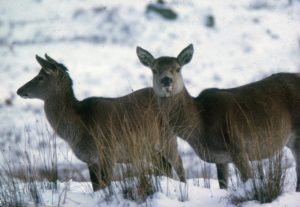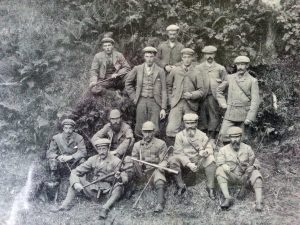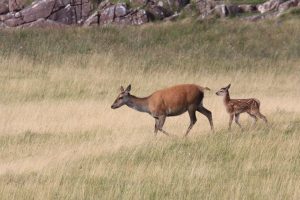By the time these lines appear in print, the traditional red deer stag season in Scotland will have closed for another year.
The stags, the captains and kings, the old Etonians, the Harrovians and the Carthusians, will have departed, each to their customary wintering grounds. The former, to Scotland’s low-lying straths and thickets – at least those which haven’t yet been planted or flooded by hydroelectric schemes – the latter to exchange their tweeds and cromachs for bowler hats and umbrellas as they alternate between their city offices and Europe’s watering-holes, content in the knowledge that all will be the same next season. Or will it?
All sport attracts criticism – the smaller the number who enjoy it, the louder the outcry. Stalking to some means toffs running around with guns. To professional local stalkers and those born and brought up in the glens, it is a way of life and their bread and butter.
The nobility of the stag, the romance of the hill and its hidden mysteries, the long days amongst nature in its most inspiring, the ever-changing light and beauty of the landscape, the fascination of watching and being close to a truly wild animal when it is unaware of being watched; all form a strong, invisible thread linking man to his ancient past. Or, as one old stalker more fluent in Gaelic than in English, said: “I never once went to the hill but the stags didn’t send me to university.”

Red deer have lived in Scotland since they walked across from Europe on the dry floor of the North Sea when the ice fields melted some 10,000 years ago. For centuries deer have fed and clothed the nation and although worth many millions of pounds a year to the Scottish economy, they are now treated by some as little better than vermin.
The main protagonists are the giddy, office-bound conservationists who see the Highlands as some sort of upland Amazonia which they feel they must protect at the expense of the indigenous people. They are not! They are a nutrient-low, species-poor, weather-beaten tundra which only the deer can properly utilise.
The environmental lobby and the Green politicians, aided by the media, are determined to reduce the deer population to an all-time low. Not for them the curve of the hill, the historical place names, the lifting of the mist, the croak of the raven, or any respect for the blue blood of the prehistoric beast filling their telescopic sights. On some places in Scotland deer are being shot and left lying where they fall to provide fertiliser and food for raptors while Third World nations starve.
For years, deer managers and stalkers have been warning landowners and the Scottish Government of the serious effect declining deer numbers will have on tourism and job losses in fragile rural communities. It is all very well for the screen-huggers and the new age conservationists to Twitter about deer damaging the “natural heritage” but trees and flowers, which have withstood their presence from time immemorial, won’t put food in people’s mouths especially given the huge rise in the world’s population, which is increasing at an alarming rate. It has to be a question of balance and common sense, and at the moment the scales are tipped heavily against the deer.
Red deer were once recognised as a national asset to the Scottish Highlands and as a permanent condition of its prosperity. Seasons were set to allow them to breed and reach peak condition. They are as much part of our DNA as our built heritage, otters, white-tailed eagles, beavers and wildcats. They deserve respect and support. If the stalkers amongst the influential politicians remain silent for much longer the real monarchs of the glen will be relegated to theme parks and zoos.
The countryside has been “managed” for so many hundreds of years, sometimes with a light, occasional touch and sometimes with a heavier shaping hand to suit more of an industrial activity as is seen in agricultural food production. Politicians and the increasing number of extremist NGOs powered by ideals and their badly informed followers regard the countryside as somewhere to exercise their duties and rights as they see fit regardless of the genuine knowledge of those that have worked and lived there often for generations.
Sadly, our world now is one of pampering to votes and gaining a following through social media, with the only absolute knowledge being that the propaganda will precipitate more funding and ‘jobs for the boys’ whilst saving the planet.
The sadness is the incessant need to tamper with the countryside to demonstrate that something is being done whilst common sense and past knowledge of those who live on the land are ignored. The failures and failings of the popularised actions that are fuelled by funding timescales are never published as the perpetrators sweep onward on the desperate hunt for the next funding package. A box supposedly ticked and onward!
None of these groups are ever held to account. I could go on about “consultants” bred on papers read and not on practical experience…but as we know history is steeped in demonstrations of how powerful propaganda can be in controlling the minds of the masses and the suppression of the minority.
Ideals come and go rather like natural selection. But it takes time and I doubt that is a luxury that we have for long. So many of today’s so-called naturalists are completely impervious to the wonderful tapestry of life and death which forms the backdrop to the natural world. They seem to inhabit some cute and cosy corner of the convenient version which they deem to be currently acceptable to Joe Public.

The present Scottish Government seems determined to phase out stalking, along with fishing, grouse shooting and all the other country sports associated with Scottish landowners. The war being waged by the SNP and the Greens against the owners of private estates is motivated by class envy but it is dressed up as a high-minded attempt to save the planet.
A friend writes, “according to these chippy little martinets, the most useful contribution Scotland can make towards reducing C02 emissions is to replace the peat moorland of the Highlands with pine trees — and in an effort to give this wanton act of destruction a veneer of romanticism, they talk about restoring the Great Wood of Caledon. The existence of this impenetrable Highland Forest was cited by Roman generals as the reason they couldn’t progress beyond southern Scotland in their conquest of Britain, but some historians think it was invented by these commanders to spare their blushes.
“The latest salvo in this campaign is a recent change to the Deer (Close Season) (Scotland) Order making it possible to shoot stags all year round rather than just between July 1 and October 20.
“That may sound like an uncharitable measure, but the Scottish Government is also intending to pay contractors millions of pounds to slaughter the native deer population. This will supposedly make the reforestation of the Highlands easier and lead to the return of species that haven’t been seen in these parts for hundreds of years, such as wolf, lynx and bear. In reality, reforestation would mean the end of stalking and the disappearance of ground-nesting birds such as the black grouse golden plover and a myriad of smaller species.
“Fortunately, 57 per cent of rural land in Scotland is privately owned and most estates will simply stop stalking stags on October 20 as they’ve always done. But the green-eyed legislators in Holyrood have a card up their sleeves in the form of the Natural Environment Bill, which they’re determined to ram through before the next Scottish parliament elections.
“This will set cull targets that the estates will be legally obliged to meet. By hook or by crook, these nature-loving politicians who get all misty-eyed when talking about ‘rewilding’ are determined to wipe out the deer population. Deer stalking and other country sports provide employment to thousands of people, forming a critical part of Scotland’s rural economy. Many of those people also look after the land and do a better job than their state-employed counterparts.”

To a Hind in the Hazel Wood
Little hind, brown among the hazels,
Grey among the twigs,
I hear the small waves lapping on the shore
And light stirring in your dark eye.
Little hind, still among the shadows,
Woven through the moss,
I see the breeze lift your pale ear,
And the bramble leaf tremble with your breath.
Your stillness is like the growing stems,
Delicate and strong;
Your gentle heart enduring as the moss,
Intricate on the rock.
Little hind of the hazel wood,
Older than the oaks,
The brown cloth of your kindred
Is wrapped about my heart like sunlight.
E J. Macdonald